I was walking to pick up a fire hydrant permit in Brooklyn yesterday when I noticed a really interesting ghost sign on the side of 208 Livingston Street:
For anyone unfamiliar with the term, a “ghost sign” is an ad for a company that no longer exists.
This one is an ad for a company called Pomeroy, and it was the unusual list of products that caught my eye: trusses, elastic stockings, abdominal belts…
…and artificial legs:
There’s just something so early-1900’s about a company using a wall sign to advertise their artificial legs, as if you might happen to be walking down the street and suddenly think, “well, I am in the market for a new left gam.” I also love the elevator entrance sign, with one of those cute little pointing hands (it’s really too bad we no longer direct people with pointing hands).
Sadly, you can no longer buy artificial limbs of any kind at 208 Livingston Street. But what was Pomeroy? And where did it go?
From the early 1800’s through the 1930’s, Pomeroy was a prominent maker of “surgical appliances” in New York City. Now, I’m no doctor, but some of these devices feel a bit like quackery to me. For example, “The Pomeroy Surgical Corset” promises to cure various ailments, including those where your internal organs start sliding below their normal position. Er, should I be concerned about this??
Pomeroy also made a number of custom-fitted “supporting belts.” If you’re not sold by the picture, the Pomeroy catch phrase (printed in italics below) is sure to win you over: “If you miss it, you do not score at all.” Huh.
Oddly, the ad closes with “One of the Pomeroy Belts – You should know them all!” It seems very unusual to know a company’s entire line of girdles…but those were different times.
Also, this anti-hernia device really freaks me out:
If you’re curious about where these elastic stockings and abdominal supporters were being made, this ad from a 1910 edition of the New York State Journal of Medicine offers a rare peek into the Pomeroy factory…
…and I’m almost positive the location featured is 208 Livingston Street, where the ghost sign is located. Several ads for elastic hosiery specifically mention the 208 Livingston address, and if it’s a further indication, the room is lined with three windows…
…which seem to match up with the building as it stands today. I checked some of the other Pomeroy addresses listed in the ads, and none seem to fit correctly.
Another picture, showing men in vests knitting elastic hosiery:
The main showroom appears to have been at 16 East 42nd Street – prime real estate!
Today, that storefront is occupied by a Cafe Metro, though one could imagine a show room on the second floor as well:
Finding anything on the history of Pomeroy is next to impossible. The last mention of Pomeroy appears in a 1936 medical journal, and then…gone. If you happen to know any more, please leave a comment!
Now if you’ll excuse me, I’m off to be fitted for a surgical corset. My kidneys feel a bit lower than usual.
-SCOUT
PS – While I was going through a bunch of turn of the century medical journals, I found this very interesting ad:
Yes, that is heroin as in heroin, and yes, the directions include a prescription for children as young as three. According to this awesome website on pre-prohibition-era drugs, heroin was used not only as an analgesic, but also asthma, coughs, and pneumonia. The glycerin (glyco) was added along with sweeteners to make the bitter opiate taste better.
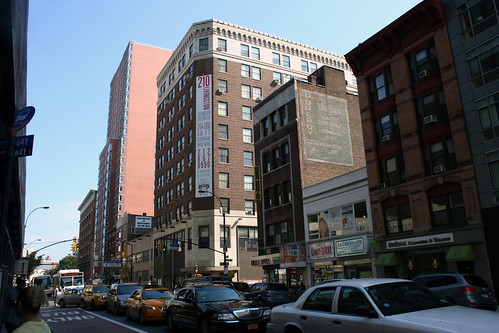
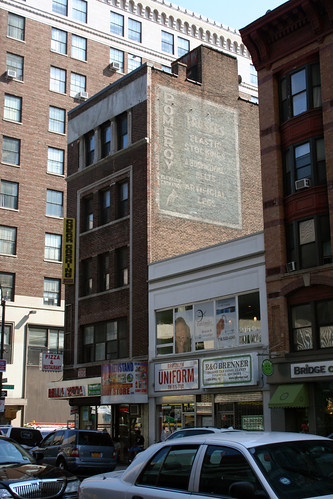

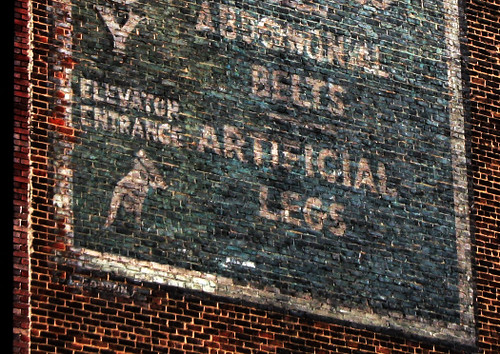
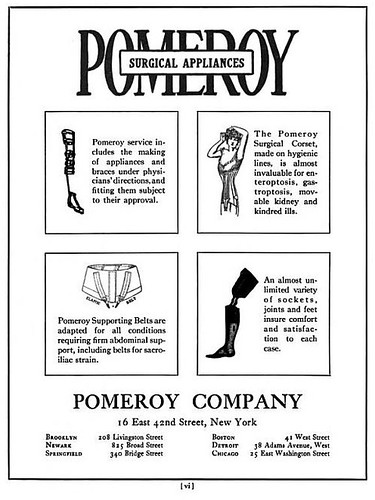

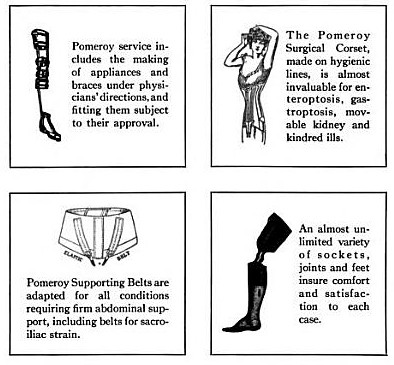
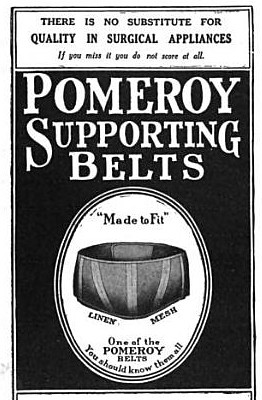
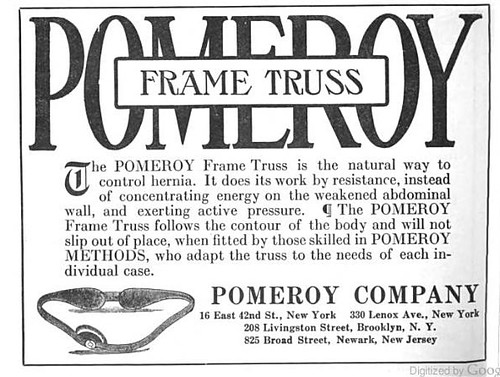

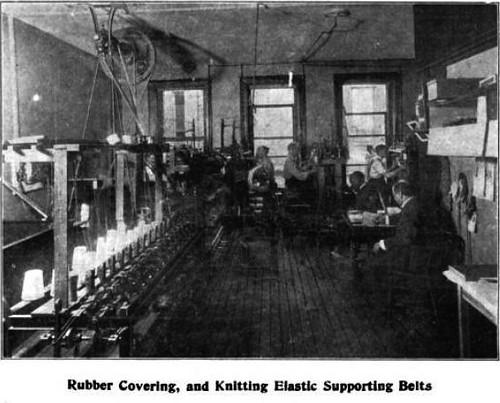

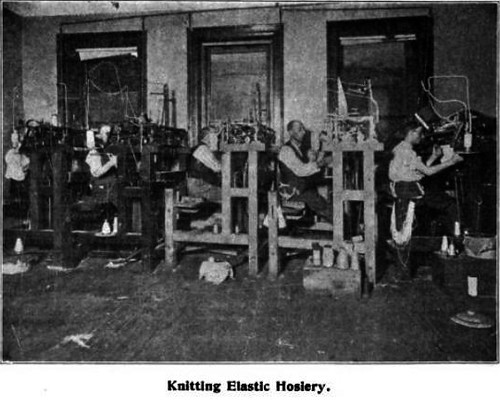
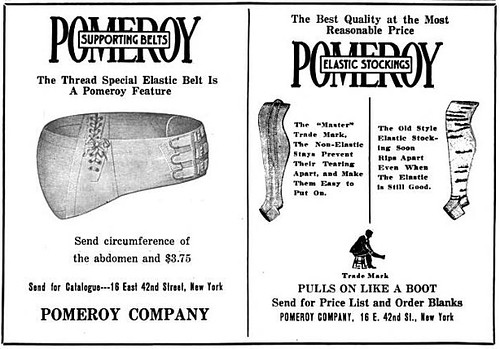

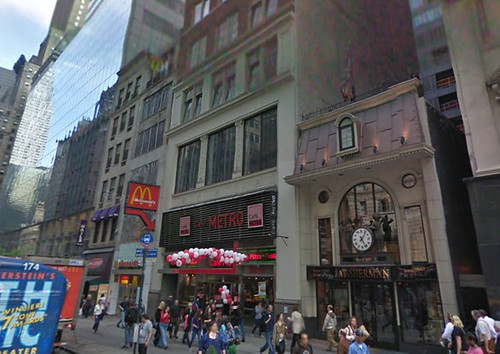
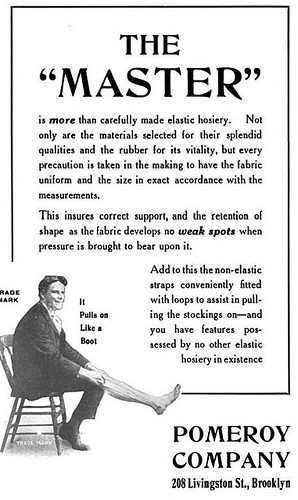
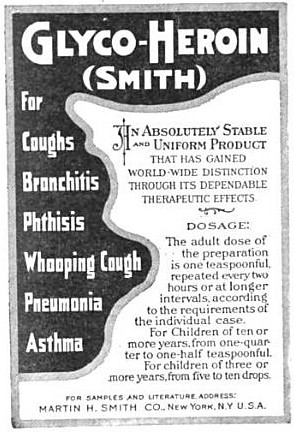

That “pointing finger” is called an Index or Manicule in typography-terms!
http://en.wikipedia.org/wiki/Index_%28typography%29
Some organs did get squished out of place from wearing corsets, but it seems odd to treat this with… more corsets. I love this post. Give me anything involving medical history and I’m raptly attentive.
What is a fire hydrant permit used for?
Neat, I worked at that Macys for a while and always wondered about that ad. I recommend checking out that Macys as well… the building is the original A&S and built in the late 1800’s. There are dog kennels on the roof from when they would just release dogs in the store at night as security, as well as tons of art deco details and a maze of tunnels underground. There is also a jail. Also since macys just ‘dropped’ their store inside the A&S (by installing walls within the old structure, making it smaller) instead of renovating it, there is about a 4′ wide crawlspace along many of the walls that still exists as A&S. Old employee bulletin boards from the 80’s, old ads for sneakers etc.
“There are dog kennels on the roof from when they would just release dogs in the store at night as security”
That’s awesome! I’d love for part of my job to be saying “release the hounds!” every day. 🙂
Now that I read it that last sentence doesn’t make any sense…but I’m sure you know what I meant.
I know they still had the dogs up through the 90’s. One of my senior display associates had been with the company for 35 years and told me a story about how a he and a few decorators were in the main room overnight hanging the big christmas garlands in the dark when all of a sudden they heard barking and dogs running toward them…. they were forced to climb the ‘towers’ in the middle of a cosmetics island and stay there for stranded until morning with the dogs jumping around. Apparently someone forgot to mention there would be associates working overnight and the dogs got released as usual.
There is a great old sign on the door going out to the roof with the kennels warning people to “not taunt the dogs”
Queen: There was a period when Macy’s was very good about preserving its architectural treasures; so your story about the old A&S in Brooklyn does not surprise me. I remember back in the 90’s hearing a story from a guy that did a consulting job for Macy’s. They basically were looking to have the old executive office suite (an entire floor) from the old Bamberger’s store in Newark taken apart and re-assembled on a couple of floors in the office tower above the 7th Avenue building. Apparently this suite of offices was solid wood paneling; hand carved detailing with matching hand carved furniture.
I always loved old department stores and the details that went into them. One of my favorites was the restaurant at the old B Altman’s at Fifth & 34th. As a child I would get dragged in their by my grandfather’s sisters.
At 302 Livingston there is a (much more modern) shop that has signs for “braces” and “artificial limbs” on its window. I wonder if Livingston used to be an Artificial Limb Row of sorts.
I found an ad in the New York Times from November 22 1906 that announces that the Pomeroy Company is moving offices & fitting rooms to 34 E 23rd St, between Broadway and Fourth.
I’ll poke around and see if I can find anything else.
It makes sense that a company selling artificial legs offers elevator service 🙂
Years ago Debbie Reynolds did a movie called Two Weeks with Love. During the course of the movie her father(God bless him) bought here a corset, but not knowing what to buy he got her a steel surgical one. As a result when her partner dipped her during a dance number the corset locked, get the picture.
I live in the burbs of Detroit and when I worked in the city I would see a lot of ghost signs on some of the older buildings, now they just paint murals over them, it’s really a shame.
I once read that after x-rays were discovered, doctors concluded that people’s organs were “sagging” and those people needed surgery STAT.
Turns out, they made this conclusion from comparing x-rays of cadavers (who were all lying down) with live people (who were standing up.) I guess they didn’t understand the GRAVITY of the situation.
YEAAAAH!
Wait, does it say “abdomonal” belts? Surely not, but that sure doesn’t look like a ‘E’ to my eye.
Henry
I live in that building! Its very old inside, with boarded up elevatod shafts. We always see that sign and wonder. Thank you so much for researching the history of Pomeroy. I will look for more signs of such a factory inside the building.